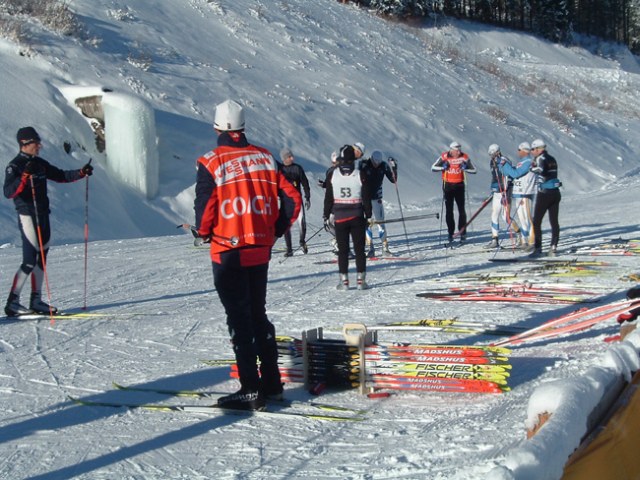Apprentice Serviceman's Report #2 - How to test skis, waxes and structures.
By: Craig Storey (2011/02/09)
If you are lucky enough to have multiple pairs of skis, you are also cursed with having to make tough choices about which pair to use on race day. Sometimes its an easy choice - your wet snow skis when its +5C and raining, not your cold powder skis. But more often conditions are in between and you'll have to wax both pairs and test them. A lot of skiers find this task daunting. They second guess their decisions and fret about it rather than doing a proper warm-up.
If you are testing wax, skis and structure for a racing team you might test 50 combinations in a morning. You need a simple, reliable testing method. The testing method I find most reliable is surprisingly simple. The drill is basically the same for choosing glide wax, grip wax, structure or selecting race skis. It requires only that you have a good feel for the difference in ski speeds. Not everyone does, but you can work on that.
Glide Testing Methods
In the world of glide testing (wax, skis or structure) there are three methods: Glide-out for distance, Glide-out with timing lights and Feel testing.
Glide out tests are conducted on a moderate downhill leading onto a flat. You can conduct these tests in or out of the track, and with or without timing lights. A glide out test for distance is done as follows:
- Mark a starting line near the top of a hill
- From stopped let yourself start to glide down the hill
- Glide until you stop
- Mark the position you stopped at and use that distance as the measure of success. The best pair of skis glides the furthest.
A glide-out test using timing lights is similarly executed, but rather than worry about the distance traveled you employ 2 electronic wands set out on the side of the track that record how long it takes you to travel from the first to the second wand. The shortest time taken, the faster the skis.
Glide-out tests have several drawbacks and are susceptible to errors:
- You need to test pairs of skis, thus you need more skis.
- If you are using the tracks you have to be very aware of whether the snow in the track is changing as you ski over it repeatedly. You might be biasing your tests just by doing them repeatedly.
- You need to be very careful with how you stand on the skis while gliding. Is your weight evenly balanced right to left, and back to front each time? Are you doing it the same for all pairs?
- Is your release at the start the same every time?
- Standing or tucking - were there gusts of wind or blowing snow in the tracks?
Even when you control some of these variables well, you still need to worry about the test course itself - does the hill you are using allow ski speeds similar to race (critical) speed. Bottom line here, glide-out test are tricky tests to execute well!
The method that I prefer is "feel" testing. You compare the "feel" of the ski on your right foot to the ski on your left. They maybe a pair of skis each waxed or structured differently, or they might be skis from two different pairs. Your job is to feel the difference between the skis and judge which one is faster.
Most people get this initial concept - find the faster ski of the pair. But too often I see coaches and athletes who should know better fail to do the testing correctly. I've seen coaches gliding down a hill alternately
balancing on the right and left ski then proclaim one faster. I've seen
skiers clip on their skis, stand still sliding them back and forth for a few seconds and then declare a
selection made. I could go on about the wrong ways to do testing, but the right way to do it is to test the skis at race speed.
Ignore how the skis feel when you first step on them, ignore how they feel just skiing around slowly. Neither of these are important to racing. You need to identify the best ski/wax/structure at race speed and nothing else counts.
To do the tests I usually use a ~20-30s sprint repeated in a few different locations. I usually use a gradual uphill, a steeper uphill, and one gradual downhill leading into a flat. If the choice isn't obvious right away I will repeat each test three times; once with each ski alternately on the right, left foot, and then right foot again. I only sprint for as long as I need to determine a difference. If you can't feel a big difference between the skis within the 30s window then it is likely there's little to choose between them.
Grip Wax or Classic Ski Testing Methods
When it comes to testing grip wax or selecting a pair of classic skis for race day there is only the "feel" method. The decisions around the best grip wax or classic ski are a bit more complicated than those required for glide wax testing. You need to determine if you have enough grip as well as adequate glide. In the end you will need to find the wax or ski that gives you the best trade off to suit the course you are racing on; no need for bomb-proof grip if you are double poling everything except a 30s hill or you might want extra grip if you climb for the first 10km.
Again, its critical that you do the testing at race speed or faster. Don't just shuffle around on the flats and expect your grip to work come race time. Its easy to get grip when you are relaxed while skiing up a gentle climb. You have all the time required to properly pre-load and weight shift. But when you need to scramble up the first big hill in that mass start you won't be skiing textbook pretty and if your grip wax wasn't tested using the same kind of stride it might not work as expected. Similarly, don't go back to your coach or wax tech and get more grip until you can ski zone 1 up the steepest uphill on the course. If you do that you may be surprised to find that while you can climb all that extra grip is slowing you down.
Test grip wax and classic race skis as if you were racing. Find at moderately steep hill you can stride up and see how well your grip works. Decide if you would be happy racing on either ski you are testing. Repeat the test with the skis on the other feet. If the wax felt good go to a steeper hill and repeat. Pick the wax or ski that works best on the critical parts of the course.
When testing grip wax you might go back and touch up the best comnbinations and re-test them. Take the ski with the best grip, but was too draggy and apply a cover wax. Take the ski that lacked grip but had great glide and add 1 or 2 layers. Did they improve? You could go around in circles for ever, but generally you'll know good enough when you test it.
So how to proceed on race day?
In my first report of the serviceman's series I outlined a typical race morning as seen from the wax cabin. What may not have been obvious in that schedule was how much work there is to do, and how tight the deadlines can be. You have to make decisions fast!
If you trusted the weatherman, you could wax the night before sleep in an show up at the race site a few minutes before the start. But because races mainly take place early in the morning, when the temperature and humidity are often changing quickly the decisions about wax and structure have to be delayed to as close to race time as possible. The test conditions should match the race conditions as much as possible so you are often testing right up to the last minute.
To test many wax combinations grip or glide without needing to rewax its nice to have several sets of matched camber skis. With matched skis you can test each individual ski, waxed differently, against every other ski regardless of pairs since the cambers are matched. If you don't have matched skis, you simply limit your tests to choosing the best ski of a pair. You can't test grip on unmatched skis against each other, since you can't determine if you are testing grip or camber.
So if you have multiple pairs of skis - 3,4 or even a dozen maybe? How to do this quickly? Just pair off skis, keep the fastest from each pair and discard the slowest. Whittle the choices down to a final pair and pick the best one. Unless you are doing testing for learning purposes there's not much use in finding the 3rd, 4th, 5th best wax, ski or structure.
If you're doing testing with many pairs of skis, you need a simple system otherwise you can get lost in the process. To begin, I lay out the skis I want to test with the bindings open. Pick the skis you think will be slowest. Do the test sprints, and pick the fastest of the pair. Take off the slow ski, close the binding to identify that you've tested and rejected it. Leave your preferred choice ski on, and pick another. Repeat the tests, closing bindings and switching skis until you have a winning pair and a preferred ski. Once you've gone through this drill a few time you might be able to test 5-10 pairs of skis in under 20 minutes.
When I'm racing and I'm usually just testing a couple pairs of skis to see which ones I want to race on. In this case I will identify the critical parts of the course. Just ask yourself "What will most of my time during the race be spent doing? I'll then tailor my tests based on that answer. I'll choose the skis that feel the best climbing on the hilly course, even if they are a bit less desirable on the flats. Be strategic, don't waste time, don't second guess after the race.
This very simple procedure can be used remarkably effectively.

Layout your skis and get to work!


